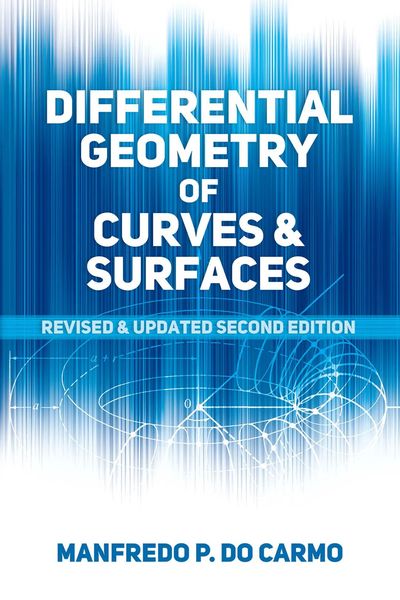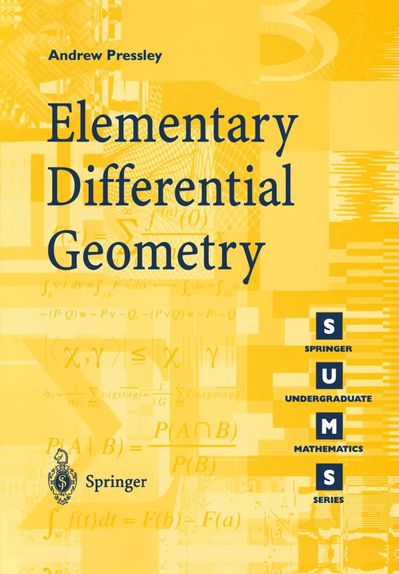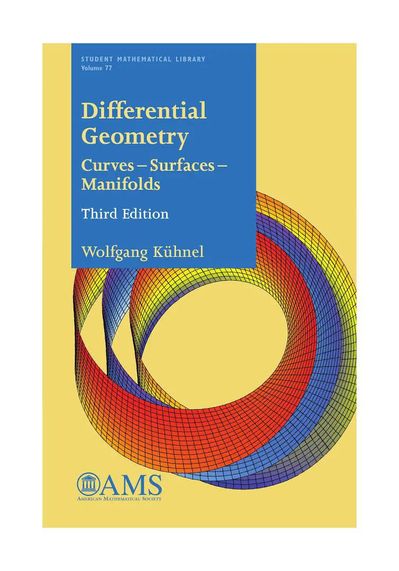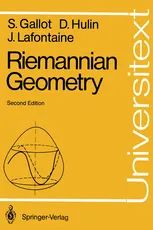目录
5 60 本教材点评
5.8 微分几何和黎曼几何 5 本

《Differential Geometry of Curves and Surfaces》
作者:Manfredo P. do Carmo
出版商:Dover Publications
出版年:2017
ISBN:9780486806990
适用范围:高年级本科生,研究生
推荐强度:8
作者简介: Manfredo P.do Carmo(1928-2018),巴西数学家,巴西微分几何学以及巴西数学学会的前主席。在微分几何领域享有权威。 他是里约热内卢应用数学研究所的名誉研究员,也是《微分形式与应用》的作者。
书评:
Most books with titles like this offer similar content. This one is no exception. There are five chapters. The first two cover curves and surfaces, respectively, in three-space (and sometimes in the plane). The chapter on curve discusses both the local and (for plane curves) global theory. The local theory addresses things like the Frenet equations, while the global theory discusses curves “in the large”, including theorems like the Four-Vertex theorem and isoperimetric inequality. The definition of “regular surface” given in the second chapter is one that generalizes easily to manifolds, and much later in the text the author does discuss the notion of a differentiable manifold, first discussing “abstract surfaces” (i.e., 2-dimensional manifolds) and then noting that there was really nothing special about the number 2 and that the idea generalizes to n-dimensions. This chapter also introduces the first fundamental form, a quadratic form that can be used to compute a lot of information about the surface (length and angle, for example).
Chapter 3 introduces the Gauss map and explores its properties and applications. The derivative of the Gauss is not just any ordinary linear mapping; it turns out to be self-adjoint, and many of its algebraic features (eigenvalues, determinant, etc.) have geometric significance. This chapter explores these, introduces the second fundamental form, and ends with a few optional sections in which, among other things, ruled surfaces and minimal surfaces are discussed.
The intrinsic geometry of a surface is addressed in the next chapter. Intrinsic properties of a surface are those that depend only on the surface itself and do not depend on the way it is situated in the ambient Euclidean space. Another way to put this is that intrinsic geometry explores concepts that can be determined from an understanding of the first fundamental form. Highlights of this chapter are the Theorema Egregium of Gauss (good luck finding this in the Index, though; after fruitless searches under T and E, I finally found it under G for “Gauss theorem Egregium”) and the Gauss-Bonnet theorem, as well as the subjects of parallel transport and the covariant derivative.
The final chapter of the book is on global differential geometry, both of the surface and curves in three-space. This rather lengthy chapter is divided into eleven subsections, many independent of the others, each proving a “big” theorem in the subject; for example, the Hopf-Rinow theorem on geodesics. This chapter has a topological flavor, but the topological prerequisites (connectedness and compactness in Euclidean spaces) are largely summarized in an appendix to the chapter.
As the above summary of the contents of this book should make clear, there is a lot of material covered in this text, far more than can be covered in a single semester. There is probably enough for two semesters, in fact, assuming that there are universities that offer two full semesters of differential geometry as part of their course offerings. For those that don’t, the author offers several suggestions for using this book in a single semester.
One topic that is not covered in the text is differential forms. In choosing to omit this topic, the author has aligned himself with the vast majority of other undergraduate differential geometry textbook authors. Indeed, the only other text at this level that I can think of, off the top of my head, that does cover differential forms is O’Neill’s Elementary Differential Geometry; I’ve always viewed that text’s inclusion of the topic as one of the chief features distinguishing it from its competition. (There are, of course, books like Shurman’s recent Calculus and Analysis in Euclidean Space that cover these, but that’s not a book on differential geometry, although it has some nontrivial overlap with the subject.) I personally subscribe to the majority (and do Carmo’s) view, but instructors who wish to introduce the subject of differential forms might want to look at O’Neill rather than this book.
I would not say that this is the best book available from which to learn this material. Nevertheless, it remains a valuable book, one that can be honestly described as a classic text in the area.
大多数书名相仿的教材都包含类似的内容,但本书却是个例外。它共有五章,前两章分别在三维空间中(有时在二维平面上)介绍了曲线与曲面。关于曲线的一章讨论了局部和(对于平面曲线的)整体理论。局部理论处理Frenet方程之类的问题,而整体理论则讨论曲线更一般的性质,包括四顶点定理和等周定理等。第二章中给出的“正则曲面”的定义,能被很容易地推广到流形。后文中作者讨论了微分流形的概念,首先讨论“抽象曲面”(即二维流形) ,然后指出这里的数字“二”并没有什么特别的,并将这个概念推广到了n维。这章也介绍了第一基本形式,一种可以用于计算与平面相关的一系列信息(例如长度或角度)的二阶形式。
第三章介绍了Gauss映射,并探讨了它的性质和应用。Gauss映射不像普通的线性映射;它是自伴随的,并且其许多代数特征(特征值、行列式等等)都具有几何意义。本章探讨了这些内容,还介绍了第二基本形式,并以一些选读内容结束,在其中讨论了直纹曲面和极小曲面。
下一章将讨论曲面的内蕴几何学。曲面的内蕴性质是指那些仅依赖于曲面本身,而与其所在空间无关的性质。另一种说法是,内蕴几何探索的概念可以由基于第一基本形式的内容来确定。本章的重点是Gauss绝妙定理(很幸运在索引中能找到它,虽然我已经费了很多功夫在T(Theorem)与E(Egregium)的索引中寻找它,最后却发现它是在字母G的索引中以“Gauss theorem Egregium”的形式出现)与Gauss-Bonnet定理,以及平行移动和协变导数。
这本书的最后一章是关于整体微分几何的,包括三维空间中的曲面和曲线。这个相当长的章节被分成十一个小节,许多小节是独立的,每个小节都证明了一个“大”定理。例如,测地线上的 Hopf-Rinow 定理。这一章的内容有很强的拓扑味道,而拓扑预备知识(欧氏空间中的连通性和紧性)则大致上被总结于附录中。
正如上述对书中内容的总结,其涵盖了大量内容,远远超出了一个学期所能涉及的范围。事实上,如果有大学能提供足足两个学期的时间来讲授微分几何,本书的内容也足够了。对那些没有充足时间的授课教师,作者提供了一些建议来指导如何在一学期的课程中使用本书。
本书没有涉及到微分形式。在选择省略这一内容时,本书作者与其他许多本科微分几何教材编者持相同意见。事实上,在本科生水平的教材中,我能想到的唯一涵盖微分形式的例外是O’Neill的Elementary Differential Geometry; 我一直认为这本书与其他教材最大的不同之一就是内容的选取(当然,也有像Shurman最近出版的Calculus and Analysis in Euclidean Space包含微分形式的内容,但那不是一本微分几何教材,虽然它和微分几何教材的内容有些重叠)。我个人赞同大多数人的观点(也赞同do Carmo的观点),但是比起本书,O’Neill的书可能更适合那些想要介绍微分形式的教师。
我不敢断定本书是学习微分几何的最佳教材。但尽管如此,它仍能派上大用场,是一本当之无愧的微分几何经典教材。
点评人:Mark Hunacek(爱荷华州立大学数学教授)
资料整理:孙华铱
翻译:赵旭彤

《Elementary Differential Geometry》
作者:Andrew Pressley
出版商:Springer
出版年:2000
ISBN:9781852331528
适用范围:科研工作者、高校教师和研究生
推荐强度:9
作者简介:Andrew Pressley(1804-1888),英国伦敦国王学院的数学教授。Andrew是国际知名学者,在数学界享有盛誉,他的研究领域主要是数学物理和统计物理方面。
书评:
When a new edition of a book I know and love is announced, I get a little nervous. It’s all too common for authors to “improve” a book in ways that make it much less interesting and much more like all the other textbooks, thereby losing most of what made the first edition distinctive and interesting. There is always a temptation, as well, to add stuff — sometimes lots of stuff — requested by users of the book, all of whom, it seems, would like their pet topic to be included.
In the light of that, I am very happy to report that the new edition of Pressley’s Elementary Differential Geometry is an even better book than the first edition, which I reviewed some time ago. Whew!
The change that pleases me the most is that the new edition makes a little more use of linear algebra. In the first edition, the Weingarten operator was never defined, with the result that a certain matrix played a very important — but entirely unexplained — role. More generally, in the first edition there was no use of the idea of the matrix of a linear transformation with respect to a chosen basis, making it harder to say certain things. In this version, the tangent plane is treated as a vector space, and we can therefore talk about operators and quadratic forms on it. I think this is great. At least in the U.S., every student taking this course is likely to have taken a linear algebra course and encountered these ideas, and every chance to reinforce and use them should be seized. In addition, this way of thinking is just easier!
The other positive change is the inclusion of a discussion of parallel transport. The book still approaches curvature in an elementary way, without introducing connections. But parallel transport is an important idea, and it’s the way most physicists think about curvature, so students should be exposed to it.
There is also some reorganization. Recognizing that instructors can have different things they want to get to in the course, the author has organized the book so that the first ten chapters contain the core material, while the final three chapters present a choice of “culminating result” one could aim for: hyperbolic geometry, minimal surfaces, and the Gauss-Bonnet theorem.
The largest addition to the book is the chapter on hyperbolic geometry. This is something I could do without, but as long as it’s segregated in a chapter of its own, I can safely ignore it. A section on spherical geometry has also been added, which the author suggests should only be covered if the instructor is aiming for hyperbolic geometry as the final topic. To my relief, the elegant treatment of Archimedes’ theorem, which does not depend on doing any detailed spherical geometry, has been preserved.
One thing that some instructors have had trouble with has not changed: there are still full solutions to all problems given in an appendix. To accommodate those of us who need to assign problem sets for credit, however, Pressley has divided his problem sets into two portions. Most of the problems are in the book and have solutions in the back. But there are more problems available on the book’s web site, and solutions are available only to instructors adopting the book. (Many of these, one must note, are problems that were in the first edition with full solutions.)
For what it’s worth, when I used the book I sidestepped the issue by requiring that students write detailed and well-explained solutions in clear, grammatical prose. The solutions given in the book are terse enough that for students to rewrite them to my specs requires actually understanding them… and that’s almost as good as solving the problem on your own. In fact, sometimes it’s harder.
The upshot is that this is still an excellent book and still my first choice for an undergraduate introduction to differential geometry.
当这本我十分喜爱的书推出新一版时,我有点紧张。对教材编写者来说,“改进”一本书后,它却不再那么有趣,同时又与同类教材更加类似进而失去初版的特点是很常见的事情。作者总面临着一种诱惑:为书本添加一些内容(有时是很多内容),这些内容是读者要求添加的,似乎所有读者都希望自己喜欢的内容被包括在内。
有鉴于此,我很高兴地通知大家,新版的 Elementary Differential Geometry 甚至比我前段时间评论过的第一版更好!
最让我高兴的变化是新版更频繁地使用线性代数。第一版从未定义Weingarten 算子,结果是某个矩阵起了非常重要的作用,却无法解释清楚。更一般地说,在第一版中,关于特定的基没有使用线性映射矩阵的概念,这使得解释一些事情变得十分困难。此版中,切空间被视为向量空间,因此我们可以讨论其上的算子和二次形式。我认为这点很好。至少在美国,每一个学习此课程的学生都应该学过线性代数,并接触过这些思想,那我们应该抓住每一个机会来强化和应用这些知识。另外,通过线性代数的角度讲授微分几何的知识更加易懂。
另一个令人欣喜的变化是此版加入了有关平行移动的讨论。这本书仍然以一种基础方式处理曲率问题,没有引入连接。但是平行移动是一个重要的概念,也是大多数物理学家思考曲率的方式,所以学生们应该适当接触一些。
此版也对内容进行了一定程度的重新编排。在认识到教师可以自由选择书中内容进行讲授后,作者重新编排了本书,使其前十章包含核心内容,而最后三章则作为可选部分,包括:双曲几何,极小曲面以及Gauss-Bonnet定理。
此版最大的变化是增加了关于双曲几何的一章。我用不上这些知识,但只要它是孤立的一章,我就可以放心地跳过它。另外此版还增加了关于球面几何学的一章,作者建议只有当教师的目标是把双曲几何作为最后的内容时,它才应该被包括在讲授内容内。让我松了一口气的是,Archimedes定理的精妙处理被保留了下来,而且并没有依赖于球面几何学的细节。
有一件令授课教师困扰的事没有改变:附录中仍包含所有习题的解答。然而,为了适应我们这些需要为学分布置作业的人,Pressley 把习题分成了两部分。书中的大多数习题仍在书末有答案。但更多的习题可以从书籍相关的网站上获得,它们的解答则只允许用本书授课的教师查看(虽然网站上的很多习题在第一版中有解答)。
值得一提的是,当我用这本书作为教材时,我要求学生用清晰的语言写出极其详尽的解答。书中给出的解答非常简洁,以至于学生要按照我的要求重写它们,就需要真正理解它们。这几乎和自己解决问题一样受益良多。事实上,有时候反而会更难。
总而言之,它仍是一本优秀的教材,也仍是我本科生微分几何入门课程教材的第一选择。
点评人:Fernando Q. Gouvêa(缅因州沃特维尔科尔比学院数学教授)
资料整理:孙华铱
翻译:赵旭彤

《Differential Geometry : Curves - Surfaces – Manifolds》
作者:Wolfgang Kühnel
出版商:American Mathematical Society
出版年:2016
ISBN:9781470423209
适用范围:本科生,研究生
推荐强度:9
作者简介:Wolfgang Kühnel,斯图加特大学数学研究所教授。
书评:
This text, published as part of the AMS “Student Mathematical Library” series, is the third edition of the English translation of Differentialgeometrie by Wolfgang Kühnel. The book provides an excellent introduction to the differential geometry of curves, surfaces and Riemannian manifolds that should be accessible to a variety of readers. The author includes a number of examples, illustrations, and exercises making this book well-suited for students or for self-study. Solutions to many of the exercises are provided in the final section of the text and there are several sections throughout the book that address topics related to special and general relativity. Frankly, this is a great book.
There are several features of Differential Geometry Curves—Surfaces—Manifolds that I really like. First, the author’s choice of, and use of notation is excellent. Second, the author strongly encourages the reader to think geometrically. In chapters 2, 3, and 4, concerned with the differential geometry of curves and surfaces, there are approximately fifty figures illustrating the geometry. Even in the later sections where it becomes more of a challenge to use figures, the author’s discussions provide geometric insight and intuition.
The third feature of this text that I would like to commend is that the vast majority of the definitions and results are boxed so that they stand out and are easy to find when flipping through the text. Last, the book is carefully written with rigorously stated definitions and results. Despite the fact that the author does not strive for complete generality at all times, one still gets the sense that one is learning modern differential geometry from this book. I feel confident that mastering the content of Differential Geometry Curves—Surfaces—Manifolds well prepares the reader to venture further into the subject.
As is true with any text, this book takes a particular perspective on the subject matter it covers. Being a book on differential geometry there is of course much discussion of curvature, metrics and tensors. However, the text does not develop the general calculus of tensors and differential forms, although the general Stokes Theorem is stated without proof and applied to derive the Gauss-Bonnet formula. I believe that the approach taken here is nonetheless appropriate for an introduction, since readers new to the subject will spend most of their time learning geometry, solving interesting problems, and seeing geometry as it relates to relativity theory. There is plenty of opportunity to learn more of the formal aspects of differential geometry in the references provided by Kühnel in the bibliography. Moreover, the content of the book will serve as an excellent source of motivation for studying further differential geometry.
I believe it would be very difficult to cover this entire book in a single-semester undergraduate course. Nevertheless, chapters 2, 3, and 4 alone offer a solid introductory course that should be accessible to advanced undergraduates, although it may be necessary to supplement the first chapter on prerequisite material. For example, in chapter 1 the implicit function theorem is stated but not proved, so that the treatment in the book may be a little terse for students seeing this background material for the first time. On the other hand, I do not believe it is necessary for students to have had a full semester of rigorous multivariable analysis to read this text, at least chapters 2 and 3. Note that after chapters 2 and 3, the reader will know about the theory of curves, the local theory of surfaces including the theory for minimal surfaces, and curves and surfaces in Minkowski space. So, even after only two chapters the reader is exposed to a lot of interesting mathematics. If you are looking to teach or learn differential geometry at an introductory level, Differential Geometry Curves—Surfaces—Manifolds is a great resource to have on hand.
本教材是Wolfgang Kühnel的著作Differential Geometry英译本的第三版,作为美国数学学会“Student Mathematical Library”系列中的一本出版。这本出色的教材为各层次的读者介绍了微分几何,涵盖曲线,曲面和Riemannian流形。本书囊括大量例子、图解与习题,十分适合读者自学。大部分习题的解答都位于教材的最后一节,此外甚至有几节讨论了狭义与广义相对论。坦率地说,它是一本出类拔萃的教材。
我非常喜欢Differential Geometry : Curves - Surfaces – Manifolds的一些特点。首先,作者对符号的选择与使用恰到好处。第二,作者强烈建议读者以几何的方式思考。在与曲线曲面微分几何有关的第2,3和第4章中,有大约五十幅插图来解释说明几何结构。即使在难以应用图解说明的后几节,作者也提供了几何上的直觉与见解。
第三,绝大多数定义与结论都被特别框出,以便轻松查阅。最后,本书定义陈述十分严格,结论叙述格外细致。尽管作者不追求将定义与结论尽可能地推广到更一般的情形,但读者仍能感受到,从这本书中,他们在学习现代的微分几何。我坚信完全掌握Differential Geometry : Curves - Surfaces – Manifolds的读者有能力在微分几何领域深造。
像所有教材一样,本书在内容编排上也有独到之处。微分几何教材不可避免地要讨论曲线、度量与张量。然而,本书没有引入张量与微分形式的计算,虽然Stokes定理在没有给出证明的情况下被直接应用于推导Gauss-Bonnet公式。我相信这种方式对一本入门教材来说是十分合适的,因为新接触这门学科的读者会将大部分时间花在学习几何、解决有趣的问题以及观察几何学如何与相对论建立联系上。借由Kühnel给出的参考文献,读者将有许多学习更深层次微分几何知识的机会。此外,这本书也会赋予读者深入学习微分几何知识的动力。
我认为要在一个学期的课程中讲完整本书的内容是十分困难的。然而,仅第2,3,4章就足以构成一门适用于高年级本科生的,扎实的微分几何介绍性课程的教材,虽然可能需要补充一些第1章的内容或预备知识。例如,第1章中陈述了隐函数定理但却没有给出证明,这对第一次看到这些内容的学生来说可能有些简略了。另一方面,我认为学生没有必要为了阅读本书上一学期的多元分析课程,至少对第2,3章而言是这样的。要注意的是,在第2,3章后,读者将会了解曲线理论,曲面(特别是极小曲面)的局部理论,以及Minkowski空间中的曲线和曲面。所以即使读者只阅读了两章,也会收获许多有趣的数学知识。如果你在找一本微分几何入门教材,无论你想自学还是想用作授课教材,Differential Geometry : Curves - Surfaces – Manifolds都是一个不错的选择。
点评人:Jason M. Graham(宾夕法尼亚州斯克兰顿斯克兰顿大学数学系助理教授)
资料整理:孙华铱
翻译:赵旭彤

《A Comprehensive introduction to Differential Geometry》
作者:Michael Spivak
出版商:Publish or Perish, Inc.
出版年:2005
ISBN:9780914098706
适用范围:高年级本科生,研究生
推荐强度:9
作者简介:Michael David Spivak是一位专门研究微分几何的美国数学家, Spivak是五卷本《微分几何综合概论》的作者。 Spivak于1964年在约翰·米尔诺(John Milnor)的指导下从普林斯顿大学博士学位。1985年,他获得Leroy P. Steele奖。Spivak在基础物理学方面作过演讲。
书评:
In the first line of his introduction to the first edition of this book, Michael Spivak says that For many years I have wanted to write the Great American Differential Geometry book. And he did. The brashness of youth must have helped, since the book grew to be five volumes long. In his introduction to the revised third edition, he says:
At one time I had optimistically planned to completely revise all this material for the momentous occasion [when the notes became a book], but I soon realized the futility of such an undertaking. As I examined these five volumes, written so many years ago, I could scarcely believe that I had once had the energy to learn so much material, or even recall how I had unearthed some of it.
The main change in the third edition is that the book has been completely re-set using TeX. (The pictures have also been redrawn.) The original edition had been simply a bound set of notes (on, I think, standard 8.5x11 paper). The second edition was more like a real book, but it was still simply photographed from typed notes. This version is much more pleasant to read.
I first met these books shortly after my first course in differential geometry. The professor followed the standard approach for such courses: minimize the machinery needed by restricting the material to curves and surfaces. This worked well, but it meant that when I wanted to move on to more advanced material, I found the language well-nigh impenetrable. What did tensors and connections have to do with the Frenet equations and the first and second fundamental forms? That, plus the horrible notation in which most books were written (for example, the nasty Einstein summation convention), effectively left me out in the cold.
I had read Spivak's Calculus on Manifolds, so when I discovered the first volume of his Comprehensive Introduction I was happy to give it a try. It was hard going. I read most of it, absorbed at least some of it, and learned to respect the author and his achievement.
In this first volume, Spivak sets up the language and context for the rest of the book, developing the theory of differentiable manifolds, vector fields, differential forms, and Riemannian metrics, with side looks at Lie groups and algebraic topology. For someone not already interested in the subject, that is, of course, overkill, and very hard to motivate. But comprehensive is the driving word, and for those who are already motivated to learn this language, this is one of the best places in which to do that.
在这本书第一版序言的第一行,Michael Spivak说: 多年来,我一直想写一本伟大的美国微分几何教材。他做到了。年轻人的无畏精神一定产生了一些作用,因为这本书已经长达五卷。在对修订后的第三版的介绍中,他表示:有一段时间,我曾乐观地计划为了这个重要的时刻(将笔记整理成专著)而彻底修订所有材料,但我很快意识到这样做是徒劳的。当我仔细阅读这五卷书时,我几乎不敢相信自己曾经有过学习如此多内容的精力,甚至不敢相信自己是如何探究出其中一些内容的。
第三版的主要变化是全书用TeX重新编排过(图片也被重新绘制)。第一版只是一套装订好的笔记(我想,是在标准的8.5x11纸上)。第二版更像是一本真正的书,但它仍只是像以电子文本形式整理好的笔记的打印版而已。此版更容易阅读。我第一次见到这些书是在我第一次上微分几何课后不久。教授遵循这一课程的传统教学方法:通过将相关内容限制在曲线和曲面上,尽可能减少所需的技巧。这很管用,但这意味着当我想继续学习更深层次的知识时,我完全无法理解它们。张量和联络与Frenet方程以及第一和第二基本形式有什么关系?再加上大多数书使用的符号都令人望而生畏(例如,讨厌的Einstein求和),让我敬而远之。我读过Spivak的Calculus on Manifolds, 所以当我发现他Comprehensive introduction系列的第一卷时,我乐于一试。它很难读懂。我读了这本书的大部分,理解了其中一部分,并对作者和他的成就抱以敬意。在第一卷中,Spivak为本系列的其余几卷建立了理论体系,介绍了微分流形、向量场、微分形式和Riemannian度量,并对李群和代数拓扑进行了简要介绍。对于一个对此领域还不够感兴趣的人来说,那种做法有些过了,而且很难使其产生学习的动力。但对于那些有志于深入此领域的人来说,这是它最出色的地方之一。
点评人:Fernando Q. Gouvêa(巴西数学家)
资料整理:孙华铱
翻译:赵旭彤

《Riemannian Geometry》
作者:Sylvestre F. L. Gallot
出版商:Springer
出版年:2004
ISBN:9783540204930
适用范围:研究生
推荐强度:9
作者简介:Sylvestre F. L. Gallot,法国数学家,在巴黎狄德罗大学获得数学博士学位,曾在里昂大学、巴黎高等师范学院工作。其专业兴趣在黎曼几何领域,1995年与Gérard Besson和Gilles Courtoi一起发现了局部对称空间最小熵的切比雪夫不等式。
书评:
From the preface: Many years have passed since the first edition. However, the encouragements of various readers and friends have persuaded us to write this third edition. During these years, Riemannian Geometry has undergone many dramatic developments. Here is not the place to relate them. The reader can consult for instance the recent book [Br5]. of our “mentor” Marcel Berger. However, Riemannian Geometry is not only a fascinating field in itself. It has proved to be a precious tool in other parts of mathematics. In this respect, we can quote the major breakthroughs in four-dimensional topology which occurred in the eighties and the nineties of the last century. These have been followed, quite recently, by a possibly successful approach to the Poincaré conjecture. In another direction, Geometric Group Theory, a very active field nowadays, borrows many ideas from Riemannian or metric geometry. But let us stop hogging the limelight. This is just a textbook. We hope that our point of view of working intrinsically with manifolds as early as possible, and testing every new notion on a series of recurrent examples (see the introduction to the first edition for a detailed description), can be useful both to beginners and to mathematicians from other fields, wanting to acquire some feeling for the subject.
This new edition maintains the clear written style of the original, including many illustrations … examples and exercises (most with solutions). Joseph E. Borzellino
自第一版以来已经过了很多年了,然而,在各位读者和朋友的鼓励下,我们才写了这第三版。这些年来,Riemannian几何有了突破性的进展。这里不是叙述他们的地方,读者可以查阅我的“导师” Marcel Berger近年的书。然而Riemannian几何不仅仅在其领域本身十分迷人。它也被证明是其他数学领域中的有效工具。在这方面,我们可以参考上世纪八九十年代四维拓扑学的重大突破。紧随其后的是最近一种可能成功解决Poincaré猜想的方法。在另一个方向上,几何群论,一个非常活跃的领域,借用了许多Riemannian几何或度量几何的思想。但让我们停停。本书只是一本教科书。我们希望,我们的观点,即尽早在流形内部处理问题,并在一些反复出现的例子上解释新引入的概念(请参阅第一版的导言以获得详细描述),对于初学者和其他领域的数学家都有帮助,以对该领域的内容产生一些直觉。
新版维持了初版清晰的风格,包括许多插图,例子与习题(大多数都有答案)。
资料整理:孙华铱
翻译:赵旭彤
